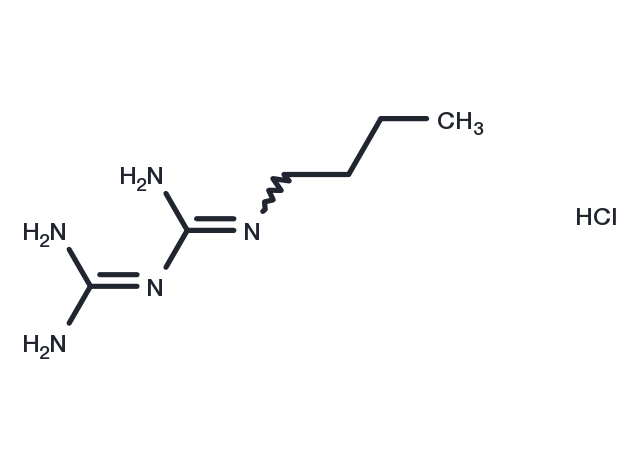Powder: -20°C for 3 years | In solvent: -80°C for 1 year


Buformin hydrochloride (NSC-528218) is a potent AMPK activator,an oral antidiabetic drug of the biguanide class. Buformin delays the absorption of glucose from the gastrointestinal tract increases insulin sensitivity and glucose uptake into cells and inhibits synthesis of glucose by the liver. Biguanides may antagonize the action of glucagon, thus reducing fasting glucose levels.

| Pack Size | Availability | Price/USD | Quantity |
|---|---|---|---|
| 10 mg | In stock | $ 30.00 | |
| 25 mg | In stock | $ 44.00 | |
| 50 mg | In stock | $ 64.00 | |
| 100 mg | In stock | $ 97.00 | |
| 200 mg | In stock | $ 158.00 | |
| 500 mg | In stock | $ 297.00 | |
| 1 mL * 10 mM (in DMSO) | In stock | $ 39.00 |

| Description | Buformin hydrochloride (NSC-528218) is a potent AMPK activator,an oral antidiabetic drug of the biguanide class. Buformin delays the absorption of glucose from the gastrointestinal tract increases insulin sensitivity and glucose uptake into cells and inhibits synthesis of glucose by the liver. Biguanides may antagonize the action of glucagon, thus reducing fasting glucose levels. |
| In vitro |
Buformin hydrochloride (0-10 mM; 5 days) inhibits SKBR3 and BT474 cells growth as a concentration-dependent manner, exhibits IC50 values of 246.7 μM and ?98.6 μM for erbB-2-overexpressing SKBR3 and BT474 cells, respectively[1]. Buformin hydrochloride (0-3 mM; 48 hours) increases the percentage of cells in G0/G1 phase and reduced the percentage of cells in S phase, especially in the SKBR3 cells[1]. Buformin hydrochloride (0-3 mM; 24 hours) suppresses RTK activation, including erbB-2 and IGF1R signaling downstream, and Akt activation/phosphorylation is inhibited in both SKBR3 and BT474 cells[1]. |
| In vivo | Buformin hydrochloride (oral administation; 7.6?mmol/kg of chow; 7 days) exhibits significantly reduced tumor volumes and weights, and?hinders mammary morphogenesis and proliferation in MMTV-erbB-2 transgenic mice[1]. |
| Synonyms | NSC528218, NSC-528218, NSC 528218 |
| Molecular Weight | 193.68 |
| Formula | C6H16ClN5 |
| CAS No. | 1190-53-0 |
Powder: -20°C for 3 years | In solvent: -80°C for 1 year
DMSO: 60 mg/ml (309.79 mM)
You can also refer to dose conversion for different animals. More
bottom
Please see Inhibitor Handling Instructions for more frequently ask questions. Topics include: how to prepare stock solutions, how to store products, and cautions on cell-based assays & animal experiments, etc.
Buformin hydrochloride 1190-53-0 Chromatin/Epigenetic PI3K/Akt/mTOR signaling AMPK agent Type II diabete inhibit Inhibitor SKBR3 cervical cancer breast cancer biguanide analog BT474 NSC528218 NSC-528218 1-Butylbiguanide antidiabetic AMP-activated protein kinase Buformin Buformin Hydrochloride NSC 528218 inhibitor
